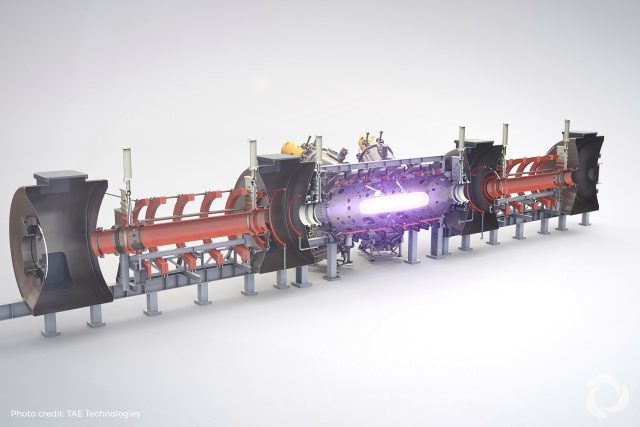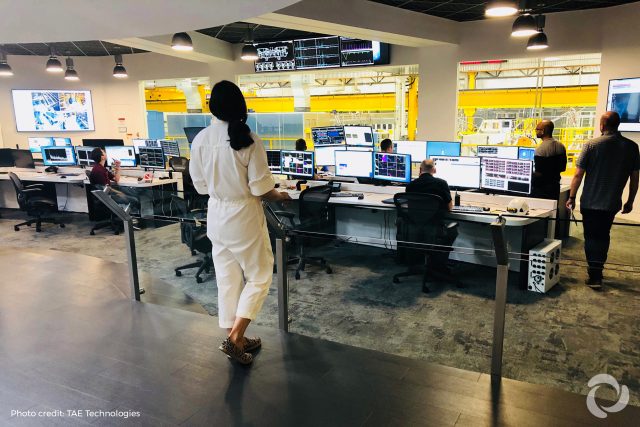
After hitting a pair of important technological milestones, TAE Technologies now believes it will be able to build a commercial-grade fusion reactor by 2030. The company said it can now sustain a plasma for an indefinite amount of time. TAE’s reactor needs to be able to heat plasma to 100 million degrees Celsius, but it recently demonstrated it can get to 50 million degrees C, which gives it confidence it can reach its goal before the end of the decade.
TAE Technologies, a privately-held spinoff of the University of California Irvine founded in 1998, has a proprietary approach to fusion, using a mechanism that produces and confines plasma, and operates at higher temperatures to achieve fusion with better stability and therefore greater safety than other technologies that try to exploit the process that powers the sun.
In an interview with EE Times, TAE Technologies CEO Michl Binderbauer described the current status of fusion energy and its applications in the future. Fusion energy could change the energy industry and support a zero-carbon economy. Improved technology and strong private funding have moved the market and other companies such as Commonwealth Fusion Systems, and General Fusion are starting to build prototypes of reactors.
TAE Technologies’ staff of engineers and scientists work in the California labs. Globally there is a staff of 250 people specialized in reactor development and nuclear fusion technologies. The company has raised over $880 million in private funding from institutional investors, including Google, NEA, Venrock, and Wellcome Trust, and family foundations of Addison Fischer, the Samberg Family, and Charles Schwab, among others.
“All of TAE’s funding has been dependent on articulating and achieving specific scientific goals. This ‘money by milestone’ approach has kept us on time and on or under budget for 20 years. Our advisors are some of the most experienced and celebrated names in science and industry. Our independent Science Panel has included over the years multiple Nobel and Maxwell Prize winners. Our Board of Directors includes Jeffrey Immelt, former CEO, GE; John Mack, former CEO, Morgan Stanley; Richard Meserve, President Emeritus, Carnegie Institution for Science and Former Chairman of U.S. Nuclear Regulatory Commission; Ernest Moniz, former U.S. Secretary of Energy; and others. In addition, TAE Technologies enjoys broad support and assistance through a wide spectrum of collaborators comprised of National Laboratories, leading universities, and global industrial players,” said Binderbauer
Fusion Energy
Nuclear fusion has the potential to provide huge amounts of clean energy, which should help mitigate global warming. A fusion power plant does not burn fossil fuels and produces no greenhouse gas emissions or long-lived radioactive waste.
For most fusion concepts, the process starts by heating different hydrogen isotopes to very high temperatures, causing individual atoms to lose their electrons and form plasma ions, a muddy substance that must be contained. Fusion then unfolds through collisions of these highly energetic ions. Huge amounts of energy can be produced, and the only byproduct is helium. The goal is to make fusion reactors self-sustaining without needing any further energy input.
TAE’s concept was born out of a desire to address the difficulties faced by conventional tokomak reactors, such as the need for deuterium-tritium handling technology, the limited availability of tritium and the size and cost of superconducting magnets. The TAE reactor, on the other hand, uses hydrogen and boron as fuel. In hydrogen-boron fusion, the reaction emits only three helium nuclei, so-called alpha particles, and x-rays, whose energy is ultimately used to drive a turbine. Commonwealth Fusion, for example, is building a variation of a tokomak.
Binderbauer highlighted that TAE’s goal is also to provide utility-scale fusion using hydrogen-boron fuel (also known as proton-boron or p-B11). “We believe it is humanity’s best bet for cost-competitive 24/7 carbon-free baseload energy. Hydrogen-boron is the cleanest, most environmentally-friendly fuel source on Earth, with no harmful byproducts and enough natural supply to sustain the planet for virtually 100,000 years. As a species we would likely be extinct by our own doing before we run out of this fuel,” said Binderbauer.
Current technology and market
Harnessing power from terrestrial fusion depends on two conditions: maintaining plasma at sufficiently high temperatures for a long enough amount of time to sustain the fusion reaction. Binderbauer said that TAE calls this the Hot Enough Long Enough (HE/LE) requirement. “For reactor performance levels, Hot Enough means reaching at least 100 million degrees Celsius, a temperature that is readily achievable today. However, sustaining that hot environment is extremely challenging because plasma is a delicate substance that must be protected from conditions that would otherwise decay it or cool it down. The goal is to confine this plasma well enough that it can be maintained with less energy than the fusion reaction generates. By doing so, net energy can then be released to the electric grid. Over the past 50 years, the different fusion efforts around the world have worked to overcome this fundamental challenge in different ways.”
TAE has made substantive progress with proprietary platform called an advanced beam-driven Field Reversed Configuration, or FRC. “Rather than the “donut” shape of the tokamaks, the FRC is a linear configuration that holds plasma in a hollow rotating football shape with high magnetic efficiency within a relatively simple magnetic field. TAE’s fusion device consists of a 20-metre-long tube (figure 1), surrounded by magnets, into which plasma rings are fired at high speed from both ends. As the rings collide, they form a hollow football inside the reactor chamber, which is then heated and stabilized by firing accelerator beams into it. This is the unique innovation pioneered by TAE. As a result, this means better containment, increased plasma stability, and a cost-competitive road to commercial fusion energy,” said Binderbauer.
By utilizing this technique, TAE has recently achieved an important scientific milestone in its Norman platform (named after TAE co-founder Norman Rostoker) and validated the company’s unique approach to fusion energy. “In previous experimental regimes, we have proven that we can sustain plasma for an indefinite amount of time (Long Enough). TAE has now validated Hot Enough with plasmas averaging 50 million degrees Celsius, just a factor of 2 away from the design goals of our next platform, Copernicus. We’re therefore confident that reaching 100+ million degrees Celsius is absolutely achievable by mid-decade, with licensing opportunities to follow,” said Binderbauer.
This achievement was supported by deploying the most advanced computing processes available, including machine learning from an ongoing collaboration with Google (which produced the Optometrist Algorithm) and processing power from the Department of Energy’s INCITE program that leverages exascale level computing.

Control Room
With the Norman milestone under the company’s belt and technologies such as superconducting magnets, machine learning, general machine control, data science, vacuum technology, accelerator technology, high-speed digital electronics now meeting up with the performance requirements of fusion, TAE expects to build a prototype power plant near the end of the decade.
Fusion is not exclusive of other technologies, and Binderbauer believes it is part of a comprehensive renewable energy portfolio. “We must deploy other forms of green energy both now and in the future, even when fusion is up and running. Fusion is a long-term approach and a powerful energy source that can ultimately provide the needed baseload power for the grid to complement solar, wind and other renewables. Because fusion is not dependent on the sun shining or the wind blowing, it can ensure readily available power at any time. Moreover, because fusion is the highest power density energy generation technology to begin with, and TAE’s configuration is safe, compact, cost-effective, and easily deployed, it can be situated close to energy demand, and reduce the need for inefficient and unsightly transmission lines,” said Binderbauer.
Developing TAE’s vision of fusion has also led to the company’s rapid commercialization of applications derived from its accelerator beam and power management technologies. For example, Binderbauer pointed out that TAE Life Sciences leverages TAE’s accelerator beams to provide a biologically targeted treatment modality to address multicentric, diffuse, and inoperable cancers. In addition, TAE is now developing partnerships in both the mobility and stationary markets to extend the range, efficiency, and faster charging of electric vehicles, as well as for deployment in residential, commercial, industrial and utility-scale grid applications.
Binderbauer said fusion is nature’s preferred source of energy. It’s the same process that powers the sun and stars, and it’s what ultimately makes life possible on Earth. TAE views fusion technology as a vital, cost-competitive component of the future global energy supply. “Our objective is to reduce human impact on the environment through a new source of safe, clean, economic, carbon-free power,” said Binderbauer
He added, “fusion is the ‘Holy Grail’ of green because it has the potential to supply the amount of energy we currently consume globally — not to mention the fact it meets the growing demand — with zero carbon emissions. Remember the early days of the pandemic? Emissions were measurably reduced because much of the world shut down for a time. Fusion could replicate those conditions (and even improve them) without the drastic downside of a global pandemic.”
Source: eetimes.com
